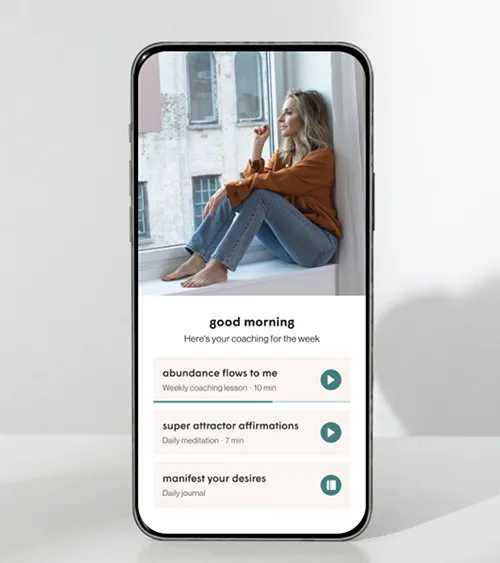Over the past several years, meditation has come fully into the mainstream. There are lots of studies on its benefits, you can find meditation videos all over YouTube, and there are multiple apps dedicated to meditating.
And yet, throughout my years of being a meditation teacher I’ve witnessed all kinds of resistance to the practice. I still do. The most common excuses for not meditating are, “I don’t have time,” “I can’t sit still,” and “Meditation is for yogis and super-spiritual people.”
Does this sound familiar? If so:
I’m here to bust the myth that meditating is difficult and not for you.
gabby
Meditation is for everyone! It doesn’t have to take much time or effort, and everyone can sit still, even if it’s just for a minute. I’m on a mission to make meditation fun and accessible for everyone, so I created this beginner’s guide to meditation.
Before we go any further, let’s begin with a few definitions so you can get familiar and comfortable with the language. Sometimes the lingo can feel off-putting, but like most things, you’ll pick it up quickly.
what is meditation?
First, what is meditation? Meditation is a practice that trains your mind. If that sounds a little vague, it’s because there are many types of meditation that are done for different purposes.
transcendental meditation
One of the most popular meditation practices in the U.S. is Transcendental Meditation, or TM for short. Transcendental Meditation is practiced twice a day for 20 minutes. During this time you sit comfortably with your eyes closed and silently repeat a mantra. A great resource on TM is the book Transcendence by Dr. Norman Rosenthal.
mantra meditation
Another term that comes up a lot is mantra, which I mentioned above. What is a mantra?
Simply put, a mantra is a word or sound that you repeat while meditating to help focus the mind. Mantra comes from Sanskrit. Man is the root of the word for “mind,” and tra is the root of the word for “instrument.”
Mantras help us disconnect from that stream of thoughts constantly flowing (sometimes rushing) through our minds. Keep in mind that not all forms of meditation use mantras.
mindfulness meditation
Another popular practice in the U.S. is mindfulness meditation, which is based on stillness and calming the mind. Mindfulness meditation often involves sitting comfortably and paying attention to your breath, your physical sensations and your environment. When your mind wanders, you gently bring it back to the present.
guided meditation
I love guided meditations because they’re very easy to follow. During a guided meditation, a teacher guides you (in person or via audio or video) through a practice. Guided meditations are great for both beginners and long-time meditators!
I created these free guided meditations that you can download instantly. All you have to do is press play, listen and follow my guidance!
the benefits of a meditation practice
Meditating has physical, mental, emotional and spiritual benefits. Here are four major benefits to having a meditation practice…
1. meditation calms your nervous system
Numerous studies prove the mental and physical health benefits of meditating. Meditating stimulates and strengthens the vagus nerve, the longest nerve in our bodies. The vagus nerve helps regulate our breathing, heart rate, digestion, circulation, muscles and more.
Meditating is also proven to lower cortisol levels. Cortisol is an important hormone when it’s within a healthy range. But far too many of us have heightened cortisol levels because of daily stress. This leads to all kinds of issues, from anxiety and poor sleep to digestion problems, high blood pressure, headaches and even heart disease.
The good news: Research shows that meditating reduces cortisol, thereby easing stress, anxiety and many physical symptoms. Your reduced stress also decreases inflammation and boosts your immune system!
2. you become less reactive
I used to be very reactive, which never worked out well for me. Inevitably, responding based on my first impulse led to a sense of regret and further complicated whatever issue I was dealing with. It was especially harmful in relationships, because I’d get very defensive and reactive when faced with arguments or challenges.
I finally got so fed up with myself that I decided to change — to make a proactive decision rather than succumb to reactions.
in stillness we can hear our intuition guiding us
Instead of doing what I always did when a challenge arose, I chose to do nothing. I chose to breathe through the discomfort and be still. In that stillness, I could hear my intuition tell me how to navigate the rest of the conversation in order to find peace more quickly.
It’s thanks to my meditation practice that I was able to get to this place of stillness in the midst of conflict. This is available to all of us: Neuroscience research shows that meditation helps us to be less emotionally reactive and more grounded, centered and mindful.
3. you recognize spiritual guidance more easily
A meditation practice isn’t just for relieving stress or silencing your racing thoughts. It does do those things — but it does so much more, too. When we meditate, we can transcend the energy of this world and step into a place of love.
By slowing down your breath and shifting into a peaceful, connected state, you can more easily receive spiritual guidance. This is because your energetic vibration is very high and you’re attuned to the love of the Universe.
In this state you’re receptive to intuitive guidance and signs from the Universe. This guidance is always available to us, but we often block it. Meditation helps us allow it.
4. you can do less and attract more
This goes hand in hand with being able to recognize spiritual guidance more easily. Meditation helps us not only notice that guidance, but also to act on it and rely on it regularly.
There is a force of love within us and around us supporting our every move. The way to access this force is to simply get out of the way. When we’re stuck in our logical and practical thought system, we can’t connect to the infinite wisdom that is available to us at all times.
We believe that our will is what makes things happen.
But the secret to feeling good and living the life we want is to stop relying on our own strength. We stop trying to control. We do less so that we can attract more.
Meditation gets us out of the way! Being guided doesn’t mean we give up our own decision-making ability. It means decisions come more easily. We feel clear and directed rather than uncertain and hesitant. When we encounter obstacles, we know we can sit in meditation, focus on feeling good, and let solutions come forward.
you can experience the benefits of meditation right away
You too can experience this power, intuition and connection by following the simple meditation steps outlined below. Remember that we call meditation a “practice” because that’s exactly what it is. It’s a habit. You do it to feel good. To calm and clear your mind and energize your body. To connect to the Universe.
You can begin experiencing the benefits of meditation right away. And over time they will grow greater and greater.
To help you demystify your meditation practice, I’ve created a beginner’s guide of 10 tips. These tips will help you start your own meditation practice, stick to it, love it and experience awesome benefits.
beginner’s guide to meditation
tip 1
anyone can meditate – you’ve just gotta want it!
Like any practice, you have to want to do it in order to achieve results. It can be hard to start a meditation practice because it seems so foreign from what we’re taught to do.
But I have good news: Meditating is much simpler than we make it out to be. Beginning your practice requires only your slight willingness. Your desire to experience something new is all you need to get on a new path.
Let’s set the intention to begin your practice now. Affirm this statement out loud to yourself:
I am open to meditation and I welcome a new practice into my life.
This simple statement will give you all the energy and enthusiasm you need to continue reading this guide and beginning your practice. It’s very important to accept that anyone can meditate as long as they want to.
tip 2
create a meditation space
It’s great to create a space in your home that is quiet, uncluttered and serene. This space can be dedicated to your practice.
But if space is tight or you travel a lot, no worries! You really can meditate anywhere. You can meditate on a park bench, at your desk, in the bathtub and even on the subway.
However, if you can, create a sacred space to meditate in. You can keep the space minimalist or fill it with items that inspire you, like tapestries or rugs, crystals, a yoga mat, a small fountain, beautiful art, mala beads, plants or a card deck. Even if you have a small apartment, you can set up a meditation pillow and light a candle.
tip 3
you DO have time to meditate
You have a minute to spare, right? One minute a day spent in stillness can change your life. Commit to one minute a day and use this practice to silence your mind and calm your energy.
If you’re still intimidated by the idea of carving out time to meditate, think about how much time you spend each day scrolling through your phone, on social media or watching TV. Then, put a new habit in place of your old ones!
The next time you go to pick up your phone or turn on the TV, take a deep breath and commit to meditating for at least 60 seconds. You can watch your show, or return to Instagram, right after that!
Here’s a meditation that literally only takes one minute:
the one-minute breath
For one minute, follow this breathing technique:
- Breath in for 5 seconds
- Hold your breath for 5 seconds
- Release for 5 seconds
Practice this breath pattern for one minute a day.
Here’s another great meditation that you can do in one minute or less every day!
tip 4
meditate by finding peace in your pulse
Meditation can be as simple as finding your pulse. This foolproof tool from my book Miracles Now is very easy for meditation newbies. I call it Peace Is in Your Pulse because it improves your concentration and brings calm to even the most scattered mind.
the peace is in your pulse meditation
- Sit comfortably cross-legged on the floor.
- Lightly close your eyes and focus on the space between your eyebrows (the third eye point).
- The mantra is Sat Nam (which means “truth identified”).
- The hand position (called a mudra) is simple. Place the four fingers of your right hand on your left wrist and feel your pulse. The fingers are in a straight line, lightly pressed on the wrist so you can feel your pulse in each fingertip.
- On each beat of your pulse, mentally hear the sound of Sat Nam.
You can use Peace Is in Your Pulse anytime, anywhere and experience great benefits in just one minute. Practice it daily to develop your intuition and calm your mind.
For more guidance, watch this video:
tip 5
meditate on the train
Do you take a train or bus to work? Instead of scrolling through your phone, use that time to get centered. Here are two easy ways to get started meditating on public transportation!
You can download my guided meditations and listen to them on the subway, on the bus or in your car while you’re safely parked.
Even better, take Dear Gabby on your next walk. When you feel good, everything you need will come to you. The more you focus your attention and energy on feeling good, the more you attract what you want to experience in life. Press play to the below episode of Dear Gabby. Let me help you get into a better mood and set the intention to feel good!
mantra for your commute
During your commute it’s helpful to repeat a mantra to yourself as you inhale and exhale.
Try this:
Breathe in: I love life
Breathe out: I am supported
Or on your way to work you may want to meditate on this mantra:
Breathe in: I love my job
Breathe out: My job loves me
Reciting a mantra while you connect to your breath can be a very powerful way to meditate.
tip 6
make cooking (and other activities) meditative
If you enjoy cooking or baking, turn it into a meditative practice. When you’re in the kitchen you can detach from your day and get creative, even if you’re just whipping up spaghetti!
The next time you feel stressed out after a long day of work, cook a delicious meal.
The key is to be deliberate. When you walk into the kitchen, set up everything you need. Play relaxing or energizing music. Take your focus off your to-do list and onto serving your soul. Enjoy the process and then enjoy the meal. Cooking is one of my favorite ways to get into the flow and feel connected.
If you aren’t into cooking, you can turn other activities into meditative practices. You can achieve a meditative flow state by dedicating some time to a favorite hobby like painting or knitting, or even while cleaning! When you bring in mindfulness and do these activities deliberately and with joy, they can become meditative experiences.
tip 7
meditate while you walk
You can find a meditative moment even when you’re walking. Walking is actually a great time to meditate because it keeps us from rushing and allows us to slow down, calm down and get grounded.
Try this simple practice the next time you’re running errands, stretching your legs on your lunch break or even grocery shopping. Slow down just a bit and make your walk meditative.
- Take a deep breath with every step.
- Feel the soles of your feet and focus on being more grounded with each step.
- Use a mantra while you walk. With each step recite this mantra: “I am calm now.”
Whenever you’re stressed, you disconnect from your body and your power. Get more grounded and connected with a walking meditation. You’ll actually enjoy your walk and feel much better when you arrive at your destination.
tip 8
find your Zen with meditation apps
Many people blame technology for their stress, lack of connection and anxiety. Tech overload keeps us up at night, often literally.
But there’s a new trend happening. Instead of being a source of anxiety or FOMO, our phones are becoming tools for stress relief. The growing trend is that people are turning to these channels for guided meditations, positive affirmations, empowering content and stress relief tools!
Check out a few of my favorite meditative apps below.
my favorite meditation apps
Headspace
As a meditation junkie I’m a huge fan of Headspace. I love this app because it makes meditation very easy for folks who are new to the practice. The app contains easy tools to help you focus more, sleep better and experience more Zen. I recommend this app to anyone who’s new to meditation or just feeling stressed out.
ConZentrate
This awesome app is really cool for starting a meditation practice. It uses an ancient meditation technique known as Trataka, which involves fixing your internal or external gaze on a point of attention. The app lets you focus on a moving ball or the “Om” mantra to get into a breathing pattern and calm your mind. You’ll be feeling super relaxed in just 10 minutes. (Also available for iPhone.)
tip 9
get grounded after meditation
When you finish meditating, it’s important to ground yourself. You may want to stomp your feet on the ground. Have a snack or drink some tea.
Do something that gets you back into your body before going back to your daily routine.
why it’s important to rest after meditating
In Transcendental Meditation it’s suggested that you rest for two minutes after meditating. This rest period helps you reorganize your energy and get back into your body.
If you quickly jump out of your meditation and start checking email or posting on Instagram, you may feel very shaky. Moving too quickly can even give you a headache or make you feel anxious. Take a few minutes to sit in a relaxed manner or lie down and rest. Let your body recalibrate.
finish your meditation with a positive intention
It’s also helpful to set an intention for the rest of your day once you finish your practice. Seal the deal with a positive intention like this one:
I choose to carry this peace with me for the rest of the day.
Set yourself up to win with a silent prayer after meditating.
it’s ok to feel awkward when you first start meditating!
When you first start your meditation practice, you may feel awkward or even uncomfortable. That’s totally normal! You don’t have to be an instant expert to benefit from meditation. You can expect thoughts to pop up throughout your meditation. Instead of getting frustrated, try to let them pass. We are human and this is just how our minds work.
If you meditate with a mantra, gently return to it whenever you catch your mind wandering. In mindfulness meditation, teachers often say to detach from those thoughts by seeing them as clouds floating in and out of your mind. The more you practice meditation — even if it’s just for a minute or two each day — the better you’ll become. But it’s not a contest or a competition. Like I said earlier, meditation is a practice.
get more guidance
- How to Live a Spiritual Life
- Meditation for Connecting to Your Higher Self
- Meditation for Healing Relationships
I can be your coach—anytime, anywhere!
My NEW gabby coaching app makes personal growth easy to access. Get weekly lessons, guided meditations and proven manifesting methods to enhance every area of your life—all inside the exclusive member’s app.

Transform your life in just 10 minutes a day with:
- Weekly coaching with practical tools that will instantly improve your life
- Quick access to 200+ meditations, affirmations, prompts, lessons and more
- ️️Quarterly challenges to release old patterns and jumpstart new habits
- On-demand access to my best motivational talks
I’ll be your coach to help you manifest your desires and live with an unshakeable sense of inner peace.



